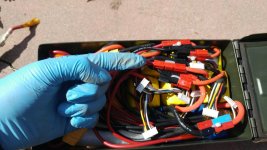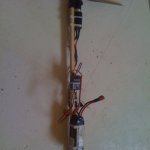methods
1 GW
Schindler Engineering Adventures. . . in Waking up @ 0420
Half of a cup of coffee in here.

A mentor of mine has gone thru 3pcs of expensive Lithium Starter pack (Automotive Starter Application) and he asked me to put together a minimal protection circuit.
Background
Typically you want to use a 3.3V chemistry for this. LiFePO4 or equ work out to a good match.
3.3V * 4cells = 12V + 1.2V = 13.2V Nominal
Typical maximum alternator output == 14.4V
14.4V / 4 = 3.6V
Which just happens to be the fully charged voltage of a LiFePO4
(big surprise there, since they were DESIGNED as lead replacement)
By Contrast - Typical Lipo Hobby Pack
3 * 3.6V = 10.8V
4 * 3.6V = 14.4V
As you can see, a 3.6V chemistry is not a good match. 3 cells is too low. 4 cells is too high. You wont be able to charge the 4 cell pack up enough for the big win. . . and the 3 cell pack will sag too hard IMHO.

Above is proof that I have started PLENTY of engines using a standard 3.6V hobby pack.
In that picture a 5.8L V8 was used on an unbalanced and previously D-Tested hobby pack to the point where one cell lit off in an impressive and hair removing fireball. ... so ... in case you were wondering. . . Y E S ... you can get quite the fireball if you go about it pig headed.

Doint it Wrong!
Dont be that guy.
What you want to do, is be *this* guy (shown below)

So...
I burned down my clock on this looking for a single picture (of the blown out Lipo) but lets rattle off the requirements real quick.
* Needs to prevent LVC failure under Starting Conditions
* Needs to prevent LVC failure under trickle Conditions
* Does not need to limit current
* Does not need to limit over-charge
* Needs to be very simple and minimally integrated
* Can not be a solid-state circuit (tho it could be)
* Must not parasitic self-kill
*
We could go on like that for a while.

At around 0445 (4:45AM) I drew the first go at it.

What that picture above calls out is the only complicated part of the circuit. In order for the BMS to control the contactor, you need a Bootstrap Voltage.
* Bootstrap Voltage must drop out @ LVC
* Bootstrap Voltage must be current limited
* Bootstrap Regulator must have a very low quiescent current

We all know by now that we can easily drive the low side coil-control mosfet with minimal current (microamps) so... not a big deal. We wont go over that any further.
One may ask about the logic of the bootstrapping
* Getting it to boot
* Getting it to let go
I included that logic in the whiteboard shot. In prose
* Current Limited regulator output appears BEFORE the key
* Turning the key OFF removes bootstrap voltage from primary contactor

In order for the circuit to work, sufficient time must be allowed between the ACC and Start functions. This time is apx 420mS. Turning the key . . probably provides enough time. . . but the failure mode is
* Turn key too fast
* Bootstrap voltage over-drawn
* Primary contactor never latches
You can deal with that 4 or 5 ways, but the easiest is to just turn the key a bit slower. A primary requirement is that the entire system install where the old battery was. If you look closely at my schematic, the only contacts are:
* Primary Chassis Ground
* Primary Positive Heavy Lug
* Any circuit post-key switch (ON a preference over ACC... to allow heaters and such to run without power on the Coil)
IIRC -
ON means you can run the Radio, heater, lights
ACC means you have voltage on the coil and are ready to fire.
anyway

The BMS circuitry is trivial and could be hacked from pre-existing modules. The most important aspects are::
* Wont kill itself if left on
So ...
Lets go thru that really quick
Current flows thru two paths
Current can flow thru Primary Contactor and thru Bootstrap Voltage
Primary Contactor opens upon LVC
Bootstrap Voltage terminates upon LVC
... So Primary Contactor coil current... standard BMS low side switch. Nothing to think about there.
for the Bootstrap regulator
* Enable Line, usually low side
* Pull its ground, if it is DC-DC Isolated
* High Side Switch (I never use these)
... Lots of options...
So
Low risk on that part of the circuit. Not worried about it at all.
The Battery will be removed from service in the event that any individual cell reaches the pre-determined (phone app set) LVC voltage.
..
For the Contactor, standard 500V 2000A gas filled DC Contactor wired in the correct direction. We would PREFER that it never blow open under load. . . BUT IT WILL. . . as you are most likely to shit out during a hard start.
So
In addition to the BMS we need a little bit of Hysteresis to stop the contactor from clackering. Most BMS's will do this, there are two primary methods
* Wait until voltage climbs to a minimum level
* Wait some fixed period of time
Obviously, we prefer the time delay. . . as you can still bounce hard with just the Voltage. Both would be best, and that is easy enough.
-methods
Half of a cup of coffee in here.

A mentor of mine has gone thru 3pcs of expensive Lithium Starter pack (Automotive Starter Application) and he asked me to put together a minimal protection circuit.
Background
Typically you want to use a 3.3V chemistry for this. LiFePO4 or equ work out to a good match.
3.3V * 4cells = 12V + 1.2V = 13.2V Nominal
Typical maximum alternator output == 14.4V
14.4V / 4 = 3.6V
Which just happens to be the fully charged voltage of a LiFePO4
(big surprise there, since they were DESIGNED as lead replacement)
By Contrast - Typical Lipo Hobby Pack
3 * 3.6V = 10.8V
4 * 3.6V = 14.4V
As you can see, a 3.6V chemistry is not a good match. 3 cells is too low. 4 cells is too high. You wont be able to charge the 4 cell pack up enough for the big win. . . and the 3 cell pack will sag too hard IMHO.

Above is proof that I have started PLENTY of engines using a standard 3.6V hobby pack.
In that picture a 5.8L V8 was used on an unbalanced and previously D-Tested hobby pack to the point where one cell lit off in an impressive and hair removing fireball. ... so ... in case you were wondering. . . Y E S ... you can get quite the fireball if you go about it pig headed.

Doint it Wrong!
Dont be that guy.
What you want to do, is be *this* guy (shown below)

So...
I burned down my clock on this looking for a single picture (of the blown out Lipo) but lets rattle off the requirements real quick.
* Needs to prevent LVC failure under Starting Conditions
* Needs to prevent LVC failure under trickle Conditions
* Does not need to limit current
* Does not need to limit over-charge
* Needs to be very simple and minimally integrated
* Can not be a solid-state circuit (tho it could be)
* Must not parasitic self-kill
*
We could go on like that for a while.

At around 0445 (4:45AM) I drew the first go at it.

What that picture above calls out is the only complicated part of the circuit. In order for the BMS to control the contactor, you need a Bootstrap Voltage.
* Bootstrap Voltage must drop out @ LVC
* Bootstrap Voltage must be current limited
* Bootstrap Regulator must have a very low quiescent current

We all know by now that we can easily drive the low side coil-control mosfet with minimal current (microamps) so... not a big deal. We wont go over that any further.
One may ask about the logic of the bootstrapping
* Getting it to boot
* Getting it to let go
I included that logic in the whiteboard shot. In prose
* Current Limited regulator output appears BEFORE the key
* Turning the key OFF removes bootstrap voltage from primary contactor

In order for the circuit to work, sufficient time must be allowed between the ACC and Start functions. This time is apx 420mS. Turning the key . . probably provides enough time. . . but the failure mode is
* Turn key too fast
* Bootstrap voltage over-drawn
* Primary contactor never latches
You can deal with that 4 or 5 ways, but the easiest is to just turn the key a bit slower. A primary requirement is that the entire system install where the old battery was. If you look closely at my schematic, the only contacts are:
* Primary Chassis Ground
* Primary Positive Heavy Lug
* Any circuit post-key switch (ON a preference over ACC... to allow heaters and such to run without power on the Coil)
IIRC -
ON means you can run the Radio, heater, lights
ACC means you have voltage on the coil and are ready to fire.
anyway

The BMS circuitry is trivial and could be hacked from pre-existing modules. The most important aspects are::
* Wont kill itself if left on
So ...
Lets go thru that really quick
Current flows thru two paths
Current can flow thru Primary Contactor and thru Bootstrap Voltage
Primary Contactor opens upon LVC
Bootstrap Voltage terminates upon LVC
... So Primary Contactor coil current... standard BMS low side switch. Nothing to think about there.
for the Bootstrap regulator
* Enable Line, usually low side
* Pull its ground, if it is DC-DC Isolated
* High Side Switch (I never use these)
... Lots of options...
So
Low risk on that part of the circuit. Not worried about it at all.
The Battery will be removed from service in the event that any individual cell reaches the pre-determined (phone app set) LVC voltage.
..
For the Contactor, standard 500V 2000A gas filled DC Contactor wired in the correct direction. We would PREFER that it never blow open under load. . . BUT IT WILL. . . as you are most likely to shit out during a hard start.
So
In addition to the BMS we need a little bit of Hysteresis to stop the contactor from clackering. Most BMS's will do this, there are two primary methods
* Wait until voltage climbs to a minimum level
* Wait some fixed period of time
Obviously, we prefer the time delay. . . as you can still bounce hard with just the Voltage. Both would be best, and that is easy enough.
-methods


